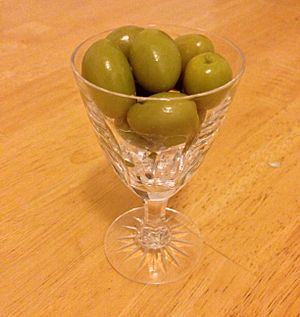Manzanilla olive facts for kids
Quick facts for kids Manzanilla |
|
|---|---|
 |
|
| Olive (Olea europaea) | |
| Origin | Spain, California |
| Notable regions | Seville |
| Use | Table and oil |
| Oil content | Low |
| Growth form | Spreading |
| Leaf | Elliptic |
| Weight | Medium to large |
| Shape | Ovoid |
| Symmetry | Asymmetrical |
Manzanilla olives (say "man-zah-nee-ya") are a very popular type of olive, often called "Spanish olives." They originally came from the area of Seville, Spain. While Manzanilla is well-known, Spain actually grows over 200 different kinds of olives!
Manzanilla olives are special because they can be used for two main things: as table olives (the ones you eat) and for making olive oil. You can find Manzanilla olives grown all over the world. When you buy them in a can, they might be green (like in the picture) or black. The black ones are made using a special method called "California black-ripe" curing.
Contents
What Are Manzanilla Olives Called?
There are many different names for Manzanilla olives, depending on where they are grown or what specific type they are. Some of these names include Early Manzanillo, Romerillo, and Manzanilla Fino.
Family Members: Related Olives
Some olive types are very similar to Manzanilla or are even mixed with it. For example, "Manzanilla Cacereña" is a close relative. Also, new types of olives have been created by mixing Manzanilla with other olives. For instance, 'Askal' is a mix of Barnea and Manzanillo, and 'Arno' is a mix of Picholine and Manzanillo. Scientists are always working to find new and better olive trees!
What Makes Manzanilla Olives Special?
Manzanilla olives are medium to large fruits that grow on the Olea europea tree. Olives are a type of fruit called a drupe, which means they have a hard pit inside, like a peach or a cherry.
You can enjoy Manzanilla olives in many ways:
- Whole: With the pit still inside.
- Pitted: With the pit removed.
- Stuffed: Pitted olives are often filled with tasty things like pimentos (red peppers), garlic, or almonds.
- Sliced: Cut into rings for salads or pizzas.
How Olives Are Made Ready to Eat (Curing)
Fresh olives right off the tree are very bitter! To make them taste good, they go through a process called curing. This process removes bitter compounds found in the olive's skin and flesh.
How Black Olives Get Their Color
Manzanilla olives have been very popular in California since the 1960s. A special way of curing, called the "California black-ripe" method, was created around 1905. This method is why most canned black olives you see are Manzanilla.
Here's how they become black:
- Green olives are soaked in a special solution that helps remove bitterness and lets oxygen in. This takes about 24 hours.
- Then, a special ingredient called ferrous gluconate is added. This helps to make the olives turn black and keeps their color.
- Finally, the olives are put into cans with a mild salty water (brine), then sealed and heated to keep them fresh and safe to eat.
Where Else Do Manzanilla Olives Grow?
The warm weather and soil around the Mediterranean Sea are perfect for Manzanilla olives. But they also grow in other places around the world!
For olive trees to grow well, they need enough cold weather in winter. This cold period, called vernalization, helps the tree rest and get ready to produce flowers. After the cold, warmer weather helps the "buds burst" and flowers appear, which then turn into olives. However, it can't get too cold (below about -16.6 degrees Celsius or 2.2 degrees Fahrenheit), or the tree might get hurt.
New Olive Varieties
More and more people are eating olives and using olive oil because it's part of the healthy Mediterranean diet. Growing olives the old way can be slow, so farmers and scientists are looking for new types of olive trees that can grow in different places and be harvested more easily by machines.
There are over 2,000 known types of olives! Scientists are always doing research, trying different ways of grafting (joining parts of two plants), and letting trees cross-pollinate (mix their pollen) to create new, stronger types of olives.
Australia
Australia has over 11 million olive trees! Manzanilla olives have shown that they can grow well in Australia's climate.
Florida, USA
Manzanilla trees are good because they can fight off pests and diseases, they can pollinate themselves, and they can handle cold weather down to at least -11 degrees Celsius (12 degrees Fahrenheit). Scientists at the University of Florida are studying if olives can grow well there. Florida doesn't get cold enough for the trees to go dormant naturally, so some growers even put liquid carbon dioxide (CO2) into the ground to help the trees rest!
Louisiana, USA
The Louisiana State University Ag Center has been testing 15 different olive types. Manzanilla is one of the types that could be grown in southern Louisiana, either for small crops or as pretty trees in gardens.
South America
Countries like Mexico, Peru, Chile, Argentina, and Uruguay also grow olives and make olive oil.
Texas, USA
Olive trees are a newer crop in Texas. Manzanilla olives are grown there, along with other types like Arbequina and Picual. Sometimes, another olive type called Pendolino is planted nearby just to help pollinate the Manzanilla trees, even though Pendolino doesn't produce much fruit itself. Olive trees can be damaged by very cold freezes, so the best places to grow them in Texas are in warmer areas like the Winter Garden Region.
See also
 In Spanish: Manzanilla (olivo) para niños
In Spanish: Manzanilla (olivo) para niños

